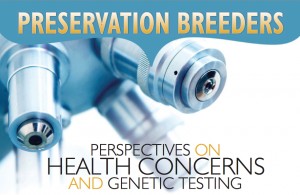Preservation Breeders – Perspectives on Health Concerns
76 – June, 2016
 PERSPECTIVES ON HEALTH CONCERNS AND GENETIC TESTING
PERSPECTIVES ON HEALTH CONCERNS AND GENETIC TESTING
BY PERI NORMAN
Responsible breeders have long considered health testing of potential breeding animals one of their distinguishing characteristics. At the time I bred my first litter in 1975, x-raying of hips was not uncommon. By the 1990s, standard operating pro- cedure included x-rays of hips and elbows and an eye exam. During that time, if a dog “failed” a health check, it was considered not to be a breeding quality animal, regardless of merit in any other area. Mentors suggested that there were other options that would be preferred to breeding an animal with a known health problem. Reputations were based (at least in part) on thorough testing and breeding only “clear” stock.
The concept of a preservation breeder has only re- cently been embraced in the world of purebred dogs. Preservation breeding is a logical extension of the ideas, research and projects that began in the 1960s with the budding environmental movement. As our society struggled with the damage being caused by rampant development and use of chemicals, as well as increasing awareness of the rapidly vanishing species of wildlife around the world, preservation and management became a subject for study as we at- tempted to bring balance to our world. Agricultural interests followed the lead of wildlife preservationists working to preserve gene pools from Heirloom toma- toes to Highland cattle. Inherent in the concept of
preservation breeding is an understanding of the im- portance of genetic diversity to the continuing sus- tainability of any population.
This evolution from responsible breeder to preser- vation breeder offers an opportunity to re-examine our thoughts about producing healthy animals. Since the completion of the canine genome map in 2005, an ex- plosion of canine genetic tests has become available with new ones being added at an astonishing pace. The AKC Canine Health Foundation shows over a hundred health tests available and that does not include avail- able testing for variations in coat color and pattern. The numbers of purebred dogs being registered (and bred) have been plummeting for decades. While some purebred dog populations are threatened with extinc- tion because of their small numbers, other breeds have plenty of numbers but are plagued by unacceptable percentages of individuals carrying or producing seri- ous disease. A preservation breeder needs to be less concerned with their reputation for producing only healthy dogs (nobody does that!), but instead hold a steadfast commitment to the health and welfare of the gene pool of entire breed.
Click here to read the complete article76 – June, 2016
Short URL: https://caninechronicle.com/?p=105606
Comments are closed











